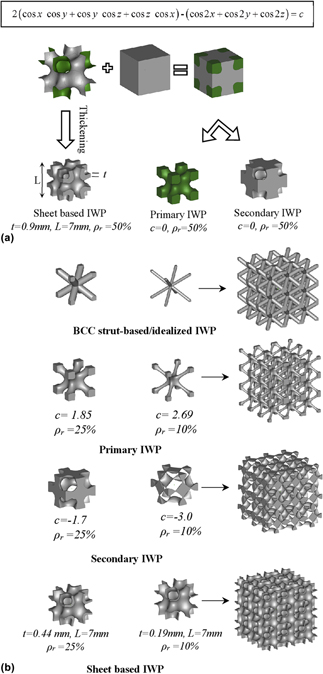Crossref Citations
This article has been cited by the following publications. This list is generated based on data provided by
Crossref.
Afshar, M.
Pourkamali Anaraki, A.
and
Montazerian, H.
2018.
Compressive characteristics of radially graded porosity scaffolds architectured with minimal surfaces.
Materials Science and Engineering: C,
Vol. 92,
Issue. ,
p.
254.
Al‐Ketan, Oraib
Rezgui, Rachid
Rowshan, Reza
Du, Huifeng
Fang, Nicholas X.
and
Abu Al‐Rub, Rashid K.
2018.
Microarchitected Stretching‐Dominated Mechanical Metamaterials with Minimal Surface Topologies.
Advanced Engineering Materials,
Vol. 20,
Issue. 9,
Vijayavenkataraman, Sanjairaj
Zhang, Lei
Zhang, Shuo
Hsi Fuh, Jerry Ying
and
Lu, Wen Feng
2018.
Triply Periodic Minimal Surfaces Sheet Scaffolds for Tissue Engineering Applications: An Optimization Approach toward Biomimetic Scaffold Design.
ACS Applied Bio Materials,
Vol. 1,
Issue. 2,
p.
259.
Tsakiris, Antonios
Salpistis, Christos
Mihailidis, Athanassios
Pantelakis, S.
and
Koubias, S.
2018.
Design Right Once for Additive Manufacturing.
MATEC Web of Conferences,
Vol. 188,
Issue. ,
p.
03020.
Aboulkhair, Nesma T.
Simonelli, Marco
Parry, Luke
Ashcroft, Ian
Tuck, Christopher
and
Hague, Richard
2019.
3D printing of Aluminium alloys: Additive Manufacturing of Aluminium alloys using selective laser melting.
Progress in Materials Science,
Vol. 106,
Issue. ,
p.
100578.
Salem, H.
Carter, L.N.
Attallah, M.M.
and
Salem, H.G.
2019.
Influence of processing parameters on internal porosity and types of defects formed in Ti6Al4V lattice structure fabricated by selective laser melting.
Materials Science and Engineering: A,
Vol. 767,
Issue. ,
p.
138387.
Mines, Robert
2019.
Metallic Microlattice Structures.
p.
75.
Al‐Ketan, Oraib
Pelanconi, Marco
Ortona, Alberto
and
Abu Al‐Rub, Rashid K.
2019.
Additive manufacturing of architected catalytic ceramic substrates based on triply periodic minimal surfaces.
Journal of the American Ceramic Society,
Vol. 102,
Issue. 10,
p.
6176.
Montazerian, H.
Mohamed, M.G.A.
Montazeri, M. Mohaghegh
Kheiri, S.
Milani, A.S.
Kim, K.
and
Hoorfar, M.
2019.
Permeability and mechanical properties of gradient porous PDMS scaffolds fabricated by 3D-printed sacrificial templates designed with minimal surfaces.
Acta Biomaterialia,
Vol. 96,
Issue. ,
p.
149.
Kolesnikova, Tatiana
Wu, Cheng Han
Han, Seung Chul
and
Kang, Kiju
2019.
Failure of P-surfaced Shellular subjected to internal pressure.
AIP Advances,
Vol. 9,
Issue. 2,
Abou-Ali, Aliaa M.
Al-Ketan, Oraib
Rowshan, Reza
and
Abu Al-Rub, Rashid
2019.
Mechanical Response of 3D Printed Bending-Dominated Ligament-Based Triply Periodic Cellular Polymeric Solids.
Journal of Materials Engineering and Performance,
Vol. 28,
Issue. 4,
p.
2316.
Mines, Robert
2019.
Metallic Microlattice Structures.
p.
97.
Al-Ketan, Oraib
and
Abu Al-Rub, Rashid K.
2019.
Multifunctional Mechanical Metamaterials Based on Triply Periodic Minimal Surface Lattices.
Advanced Engineering Materials,
Vol. 21,
Issue. 10,
Alabort, Enrique
Barba, Daniel
and
Reed, Roger C.
2019.
Design of metallic bone by additive manufacturing.
Scripta Materialia,
Vol. 164,
Issue. ,
p.
110.
Savio, Gianpaolo
Meneghello, Roberto
and
Concheri, Gianmaria
2019.
Design of variable thickness triply periodic surfaces for additive manufacturing.
Progress in Additive Manufacturing,
Vol. 4,
Issue. 3,
p.
281.
Ramírez, Jhon Alexander
Ospina, Valentina
Rozo, Angie A.
Viana, Maria I.
Ocampo, Sebastian
Restrepo, Sebastian
Vásquez, Neil A.
Paucar, Carlos
and
García, Claudia
2019.
Influence of geometry on cell proliferation of PLA and alumina scaffolds constructed by additive manufacturing.
Journal of Materials Research,
Vol. 34,
Issue. 22,
p.
3757.
Soyarslan, Celal
Blümer, Vincent
and
Bargmann, Swantje
2019.
Tunable auxeticity and elastomechanical symmetry in a class of very low density core-shell cubic crystals.
Acta Materialia,
Vol. 177,
Issue. ,
p.
280.
Al-Ketan, Oraib
Rowshan, Reza
Palazotto, Anthony N.
and
Abu Al-Rub, Rashid K.
2019.
On Mechanical Properties of Cellular Steel Solids With Shell-Like Periodic Architectures Fabricated by Selective Laser Sintering.
Journal of Engineering Materials and Technology,
Vol. 141,
Issue. 2,
Abu Al-Rub, Rashid K.
Lee, Dong-Wook
Khan, Kamran A.
and
Palazotto, Anthony N.
2020.
Effective Anisotropic Elastic and Plastic Yield Properties of Periodic Foams Derived from Triply Periodic Schoen’s I-WP Minimal Surface.
Journal of Engineering Mechanics,
Vol. 146,
Issue. 5,
Zhou, Hailun
Zhao, Miao
Ma, Zhibo
Zhang, David Z.
and
Fu, Guang
2020.
Sheet and network based functionally graded lattice structures manufactured by selective laser melting: Design, mechanical properties, and simulation.
International Journal of Mechanical Sciences,
Vol. 175,
Issue. ,
p.
105480.



